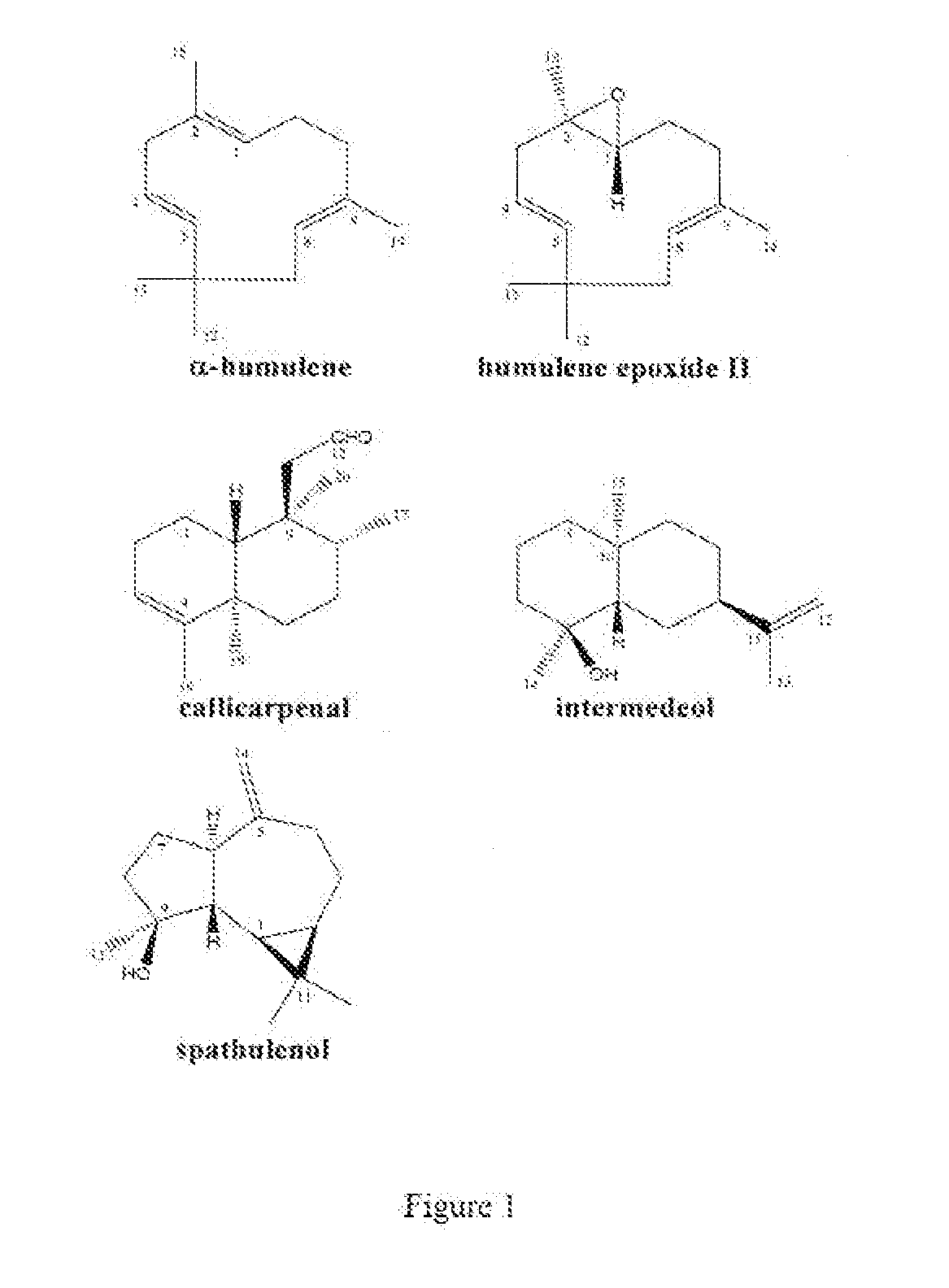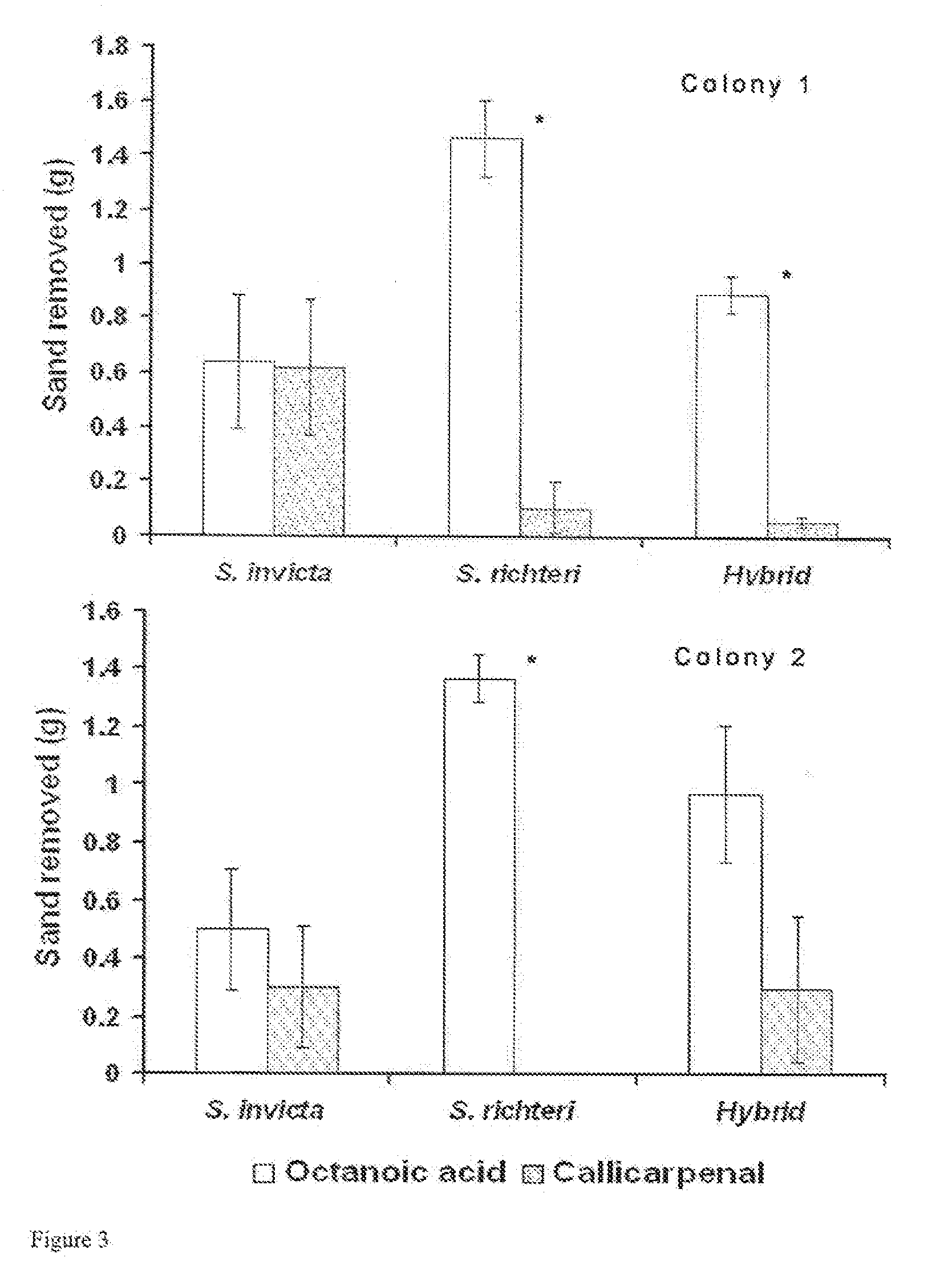Novel Clerodanes and Methods for Repelling Arthropods
a technology of arthropods and clerodanes, applied in the field of new clerodanes and methods for repelling arthropods, can solve the problems of no longer allowing child safety claims on labels tor deet-containing products, and recent concerns about the potential toxicity of deet to children
- Summary
- Abstract
- Description
- Claims
- Application Information
AI Technical Summary
Benefits of technology
Problems solved by technology
Method used
Image
Examples
example 1
[0030]General Procedures: 1H- and 13C-NMR spectra were recorded in CDCl3 on a Bruker Avance 400 MHz spectrometer, High resolution mass spectra were obtained on either a JEOL AccuTOF (JMS-T100LC) or an Agilent LC / MSD TOF. Column chromatography was performed using a Biotage, Inc. Horizon™ Pump equipped with a Horizon™ Flash Go Hector and fixed wavelength (254 nm) detector.
[0031]GC-MS Analysis; Oil extracts of C. americana and C. japonica were analyzed by GC-MS on a Varian CP-3800 GC coupled to a Varian Saturn 2000 MS / MS. GC was equipped with a DB-5 column (30 m×0.25 mm fused silica capillary column, film thickness of 0.25 μm) operated using the following conditions: injector temperature, 240° C.; column temperature, 60-240° C. at 3° C. / min then held at 240° C. tor 5 min; carrier gas, He; injection volume, 1 μL (splitless). MS ionization energy set to 70 eV.
[0032]Plant Extracts: Leaves of C. americana were collected in July from a single large plant (4 m. tall×5 m. wide) growing in Laf...
example 2
[0060]Sodium borohydride reduction of callicarpenal: Callicarpenal (21.9 mg) was seated in dry methanol (10 mL) with excess NaBH4 (150 mg) at room temperature for 95 min. The reaction was worked up by adding H2O and extracting with CH3Cl. The concentrated dried CH3Cl extract was separated by preparative TLC (H:EtOAc, 80:20) which furnished the primary alcohol, 13,14,15,16-tetranosclerod-3-en-12-ol;
[0061]13,14,15,16-tetranorclerod-3en-12ol. High resolution ESI-MS m / z 237.2059 [M+H]*, calculated for C16H29O, 237.2218. 1H NMR (400 MHz in CDCl3): δ 5.22 s (1H), 3.65 m (2H)j, 2.08 m (1H), 2.04 m (1H), 1.61 br s (1H), 1.03 s (3H), 0.90 d (J=6.0 Hz, 3H), 0.78 s (3H). 13C NMR (400 MHz in CDCl2): δ 144.5 s, 120.7 d, 58.9 t, 47.8 d, 41.2 t, 39.0 s, 38.5 s, 37.6 d, 36.9 t, 27.7 t, 27.0 t, 20.2 q, 18.8 t, 18.5 q, 18.1 q, 16.4 q.
[0062]Oxidation of callicarpenal to 13,14,15,16-tetranorclerod-3-en-12-oic acid: To a solution of 50.7 mg of callicarpenal, 2-methyl-2-butene (0.338 ml), NaH2PO4 (91.9 m...
example 3
[0065]m-CPBA Oxidation of Callicarpenal to Epoxides: A solution of 75.4 mg of callicarpenal in 2 ml CH2Cl2 was added to a solution of 1.5 molar equivalents m-CPBA in 2 ml CH2Cl2 and stirred in an ice bath for 1 h. The reaction mixture was washed three times with 5 ml 0.01 M NaOH solution and once with 5 ml of distilled H2O. TLC of the reaction mixture revealed at least two products. Accordingly, the crude mixture (69.4 mg;) was adsorbed to silica gel and applied to a silica gel chromatography column (25 mm×150 mm, 60 Å, 40-63 μm). Elution of the column was performed using increasing polarity mixtures of hexane / ether in a series of three linear steps as follows: (step 1) 100:0 to 80:20 using 1200 ml, (step 2) 80:20 to 50:50 using 1599 ml (step 3) 50:50 to 0.100 using 600 ml. A total of 142 24 ml test tubes were collected, and on the bash of thin-layer chromatography (TLC) similarities, recombined into three fractions (A, 68-76; B, 77-78; and C. 79-88), Fraction A afforded 11.9 mg of ...
PUM
| Property | Measurement | Unit |
|---|---|---|
| temperature | aaaaa | aaaaa |
| thickness | aaaaa | aaaaa |
| thickness | aaaaa | aaaaa |
Abstract
Description
Claims
Application Information
 Login to View More
Login to View More - R&D
- Intellectual Property
- Life Sciences
- Materials
- Tech Scout
- Unparalleled Data Quality
- Higher Quality Content
- 60% Fewer Hallucinations
Browse by: Latest US Patents, China's latest patents, Technical Efficacy Thesaurus, Application Domain, Technology Topic, Popular Technical Reports.
© 2025 PatSnap. All rights reserved.Legal|Privacy policy|Modern Slavery Act Transparency Statement|Sitemap|About US| Contact US: help@patsnap.com



